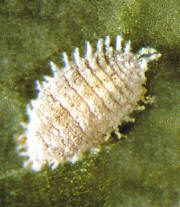North Tapanuli Indonesia is one area that has potential for agricultural development coffee plant since 18 Century age. This area are export this quality coffee product to Europe since this century that mentioned.
But with time running the current production of coffee plants in there decreased one reason is because of pests and diseases.
Therefore, through this article BP4K North Tapanuli try to give the introduction of coffee pests and plant diseases and control.
1. Nematode Parasites
 This is parasitic nematodes on coffee plant when at seedling stage. Pratylenchus coffeae and Radopholus similis is an endoparasitic nematodes are sedentary. P.coffeae life cycle of about 45 days and R.similis about 1 month.Symptoms:
This is parasitic nematodes on coffee plant when at seedling stage. Pratylenchus coffeae and Radopholus similis is an endoparasitic nematodes are sedentary. P.coffeae life cycle of about 45 days and R.similis about 1 month.Symptoms:
Coffee plants are attacked appear stunted, leaves turn yellow and fall. Growth stunted primary branches so that only produce a little flower, flower prematurely and many are empty. Parts of the roots of the fibers rot, brown or black. In severe attacks the plants eventually die.
Control:
Control in the nursery: It is recommended to use chemical means is the fumigate fumigant media using pre-seed crops, such as Basamid Vapam G and L. For systemic and contact nematisida al: Curaterr 3G, Vydate 100 U.S., 10G and Rugby 10G.Vydate Rhocap applied by sprayed on the seedlings with a concentration of 1.0% and a dose of 250 ml / seedling.
Control in a plantation: The use of parasitic nematode resistant varieties of coffee. Used as rootstock for example coffee ekselsa (Coffeae exelsa), 121.09 BGN clones of robusta coffee clones and 961 BP. Way of technical culture: opening the planting hole, making crop rotation and barrier trenches.
Biological control: In order to suppress nematode populations using natural enemies in the form of bacterial, fungal and nematode predators.
Chemical control: Several systemic and contact nematisida suggested al Carbofuran (Curaterr 3G-35 g / plant), oksamil (Vydate U.S. 100 1.0% 1 – 2.5 l / plant) and etoprofos (Rhocap 10G – 25 g / plant). Application was repeated every three months.
2. Borer on Coffee Fruit
 Adult insect borers in fruit or powdered coffee cherries (BBK), Hypothenemus hampei (Coleoptera, Scolytidae) brownish-black, female length about 2 mm and a male 1.3 mm. Eggs are laid in the coffee fruit seeds begin to harden, the age-stage eggs 5-9 days. Long larval stage 10-26 days, pre pupa 2 days and pupal stage 4-9 days. Developmental period from egg to adulthood 25-35 days. Old female insects live on average 156 days and a maximum of 103 days the male insect.
Adult insect borers in fruit or powdered coffee cherries (BBK), Hypothenemus hampei (Coleoptera, Scolytidae) brownish-black, female length about 2 mm and a male 1.3 mm. Eggs are laid in the coffee fruit seeds begin to harden, the age-stage eggs 5-9 days. Long larval stage 10-26 days, pre pupa 2 days and pupal stage 4-9 days. Developmental period from egg to adulthood 25-35 days. Old female insects live on average 156 days and a maximum of 103 days the male insect.
Symptoms:
BBK insects get into the coffee fruit by making a hole in the disc. The attack on the young fruit causing the fruit fall, assault on a fairly old fruit causes the coffee beans with holes and defects of low quality.
Control:
Control of the technical culture: Breaking the cycle of life BBK, including measures: Pick powder, which started the harvest by picking all the ripe Remove the affected powder of 15-30 days before harvest.
The collection of the coffee fruit that fell on good ground to develop the fruit and the fruit does not develop, then the fruit is also soaked in hot water. Racutan / loot, which is picking all the fruit on the tree at the end of harvest. All fruit picked powders, and hot water 5 minutes. Setting shade to avoid planting too dark conditions suitable for the development of BBK.
Biological control: Using Cephalonomia stephanoderis parasitoids and fungal pathogens (Beauveria bassiana). B.bassiana application is recommended at a dose of 2.5 kg per hectare solid culture for three applications per crop season.














 2. Aphids (Aphis Sp)
2. Aphids (Aphis Sp) 

 5. Thrips (Thrips tabaci)
5. Thrips (Thrips tabaci) 





 2. Flies Seeds (Antherigona exigua Stein)
2. Flies Seeds (Antherigona exigua Stein) 4. Leaf caterpillar (Prodenia litura F)
4. Leaf caterpillar (Prodenia litura F) 5. Stem borer (Sesamia inferens Wlk)
5. Stem borer (Sesamia inferens Wlk) 6. Army worm (Leucania unifenuta HAW)
6. Army worm (Leucania unifenuta HAW) 7. Cob worm (Heliothis armigera HSN)
7. Cob worm (Heliothis armigera HSN) 9. Helminthosporium diseases
9. Helminthosporium diseases 




 Pest snails are very detrimental to plant dragon fruit because of damage by gnawing the trunk or branches and branches can lead to rot. Pest is due to a lack of cleanliness maintained gardens.
Pest snails are very detrimental to plant dragon fruit because of damage by gnawing the trunk or branches and branches can lead to rot. Pest is due to a lack of cleanliness maintained gardens.